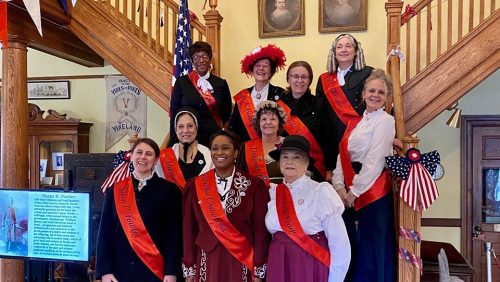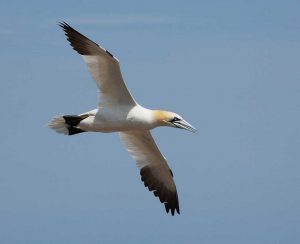 Back in 2007 I had the pleasure of visiting biologist Dick Veitch in New Zealand. We first met on the Delaware Bayshore where for many years he lent his expertise in shorebird ecology to the New Jersey shorebird recovery team. Dick’s career was spent working with the New Zealand Wildlife Service (currently the Dept. of Conservation). His expertise lies in the recovery of endemic island birds brought to the brink of extinction by the feral cats and rats that had been introduced by European colonists and dramatically impacted many native species.
Back in 2007 I had the pleasure of visiting biologist Dick Veitch in New Zealand. We first met on the Delaware Bayshore where for many years he lent his expertise in shorebird ecology to the New Jersey shorebird recovery team. Dick’s career was spent working with the New Zealand Wildlife Service (currently the Dept. of Conservation). His expertise lies in the recovery of endemic island birds brought to the brink of extinction by the feral cats and rats that had been introduced by European colonists and dramatically impacted many native species.
Dick is most famous for his work on a flightless nocturnal parrot that is seriously endangered—the kakapo. In order for recovery efforts to be successful, all feral cats and European rats had to be eradicated wherever kakapo raise their young. Birds that nest on islands and precipices are seeking protection from predators that are more plentiful on the mainland. Ground-nesting birds like the kakapo are especially susceptible to predation.
Dick took me to Miranda, on the Firth of Tames, a 20,000-plus acre coastal wetland famous for its wading birds. I scoped the shore as he waited for my reaction to what I saw: “Sanderlings, I suppose. What in the name of…?”
“They’re wrybills,” he told me, as I expressed my amazement.
“Do they all turn the same way?”
“Indeed, only right, they’re the only bird in the world with a sideways curved beak.”
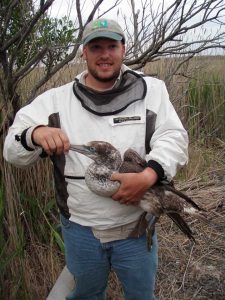
Our mind sees what we expect to see. As members of the plover family, wrybills in their non-breeding plumage lack the dark chest bar and they really looked like sanderlings. Since birds face the wind for lift, from the side they looked ordinary. It wasn’t until one of them turned that the bent bill became evident. It was bizarre!
The following day Dick had another surprise in store. He took me to the cliffed shoreline of New Zealand, Muriwai, about an hour west of Auckland. Beneath us on a ledge were thousands of gannets with their young. They lay just one egg, and each adult was coupled with a fluff-ball hatchling about two-thirds the size of its parent. Looking down at them we could see the golden napes of the adults contrasted by their snow-white bodies accented by the ebony black wing tips. What we were observing was Australasian gannet or Morus serrator, extremely similar to our northern gannet Morus bassanus and the gannets off southern Africa, the Cape gannet. At one point in time they were considered to be the same species; likely their geographical separation has led to their speciation.
There are a host of scholarly articles about their differences, and beyond location and specific diet preferences, I will leave the discussion of these differences for those who study DNA. In other words they look alike, to both experts and lay people. And they look gorgeous, their feathers lying like satin against their bodies. Their body and head extend an equal distance on either side of the wings, giving a lovely symmetry to their very flat-winged profile with black wingtip accents. These birds are closely related to boobies, with a heavy bill, short legs, webbed feet, and a six-foot wingspan.
So we have gone halfway around the world and now I’d like to bring us back home. In the North Atlantic Ocean northern gannets nest in very few areas; there are fewer than 30 large colonies. About half of these are found along the shores of Great Britain, two in Iceland, three in France, one in Italy, and six in Canada, essentially located in Newfoundland and New Brunswick.
In the winter the birds from Canada move to more southern climes along the east coast, and we get to see them! If you like birds, even only a little bit, this is undeniably one magnificent specimen—the largest seabird in the North Atlantic. CU took a Cape May Ferry crossing on November 2 to visit the Cape Henlopen State Park in Delaware where we saw just one gannet, since the colder weather had not yet brought our northern neighbors southward.
More recently, on the 18th, I found three friends who were game to ride the ferry to view gannets, and as luck would have it we had exquisite weather. The temperature had chilled enough in the intervening time period that a dozen or two migrants were on hand and put on a show flying the wake of the ferry.
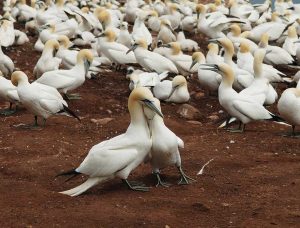
March is said to be the best month for gannets in the Delaware where you might see hundreds or even thousands. November and December are also a good time to view southbound gannets from the Avalon Seawatch Cape May Bird Observatory.
About one mile into the 17-mile crossing birds begin to fly over the wake of the ferry, primarily herring and black back gulls. Then in short course, a little over a mile into our trip, we begin to notice the sleek body shape and black wingtips of the gannets. Seabirds fly over the wake of large boats because the forward movement causes strong upward currents, an updraft that the birds can ride with little effort. This is why they circle and rise up, hovering over the rear of the vessel. In addition, small fish on the bottom are disoriented by the waves of the wake and become easier targets for these drafters.
The gulls seem to circle more than the gannets, which cut across the wake frequently, sometimes gliding along the water and other times seeming to rise high and far to the outsides of the wake and occasionally strafing over it. They cut the air with precision, where the gulls seem to bob and float more. It is likely that gannets use the boat more for feeding opportunities than wind deflection.
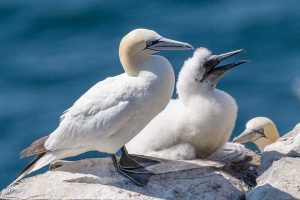
Gannets seldom come to land except for colonial nesting on cliff outcroppings and rocky islands. Their ground nest is rather flat and made from seaweed, grass, and feathers. Like osprey they add odds and ends that show their interface with humans, e.g. rope, plastic, toys, fishing line, golf balls, gloves, false teeth… you might say “kitsch.”
Each monogamous pair lays one chalky-blue egg. Since they lack a brood patch, which is a featherless area on breast or abdomen that helps in incubation, they employ their webbed feet to warm the eggs. If you have a foot fetish their feet are worthy of inspection, each toe between the dark webbing being a bright blue-green color with a claw on the tip.
The egg is incubated for 44 days and the young are altricial at birth, downless and with eyes closed. Both parents will raise the chick. Mating bonds commonly last 10 years. The nestling will look like a huge cotton ball in its downy state and later be a charcoal version of the adult. Prior to fledging, chicks will exercise their wings in preparation for flight. Upon fledging at 13 weeks, the immature bird is nearly nine pounds while adults are five to eight pounds. This is a substantial difference that will be lost over a week’s time.
When the chicks take their first running steps and leap off their precipice it is a fly-or-die commitment. Height and updrafts along cliff faces greatly facilitate flight. Even when fishing, to take off from the water they must run a few steps along the surface to get airborne.
It is not unusual for exhausted migrating gannets to be found beached. The rigors of being a seabird take their toll, especially on immature birds. My first good look at an immature gannet in hand was in 2009 when the New Jersey shorebird team was joined by the Southeastern Cooperative Wildlife Disease Study group, which takes blood samples of the captured shorebirds in search of avian-related viruses. Ben Wilcox had found an exhausted immature gannet along the Delaware Bayshore and examined it for injury. Birds can doze half of their brain at a time, so sleep can be achieved in flight. Other than while nesting, gannets rest only in flight or at sea.
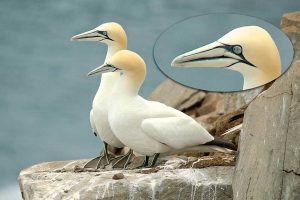
It takes the nearly black immature bird five years to reach maturity and several molts to achieve the white plumage of its adult counterpart. The closest nesting colonies to New Jersey are in Newfoundland/Labrador, the best known being Bonaventure Island and Cape St. Mary’s Ecological Reserve’s Bird Rock. Bonaventure has one of the world’s largest nesting colonies, with some 110,000 gannets comprising more than half the 200,000-plus birds in residence there. St Mary’s is the most accessible seabird rookery in North America and the third largest nesting site and southernmost colony of northern gannets in North America, with about 20,000 gannets. Both are also nesting sites for gulls, razorbills, common murres, black-legged kittiwakes, and double-crested cormorants.
Gannets are fishermen, eating small bait fish like menhaden, mackerel, and herring, and also squid. In flight they can average 40 miles an hour. When fishing they set their wings back and make an arrow-shaped stoop, attaining speeds of 65 miles an hour before penetrating the water at nearly 10 feet. They may swim an additional 60 feet underwater. Especially equipped for the rigor of these dives, they have no external nostrils; instead these are within their mouth. They have air sacs under the skin of their face and chest that cushion their muscles when they impact the water. Their eyes are forward-facing like more predatory birds, allowing them binocular vision for accuracy.
Ah those eyes! Adele and Lady Gaga, prepare to take the back seats, please. A gannet’s eye makeup would make Cleopatra weep with jealousy. They have a blue orbital ring surrounding the pale blue-gray iris, and black eyeliner that won’t quit surrounding the eye, making a smile from the bill’s hinge toward the nape, then extending down the beak to its tip. Forward of the eye there is a thin line down either side of the beak’s ridge. And all this is framed by the buffy-golden velvety plumage of the head. Wowzah.
So why not grab your binoculars, cruise the Bayshore Heritage Byway, hop the ferry, and watch some gannets. You might like to lunch at Lewes and dine in Cape May. Don’t forget to bundle up!
Sources:
Special thanks to Clay Sutton for his input.
The Birders Handbook, Ehrlich, Dobkin and Wheye.
Animal Diversity Web
NewfoundlandLabrador.com
All About Birds, The Cornell Lab
Parkscanadahistory.com
Do not disturb! Migrating Northern Gannets aren’t injured — they’re resting, Erick Gill, to TCPalm







